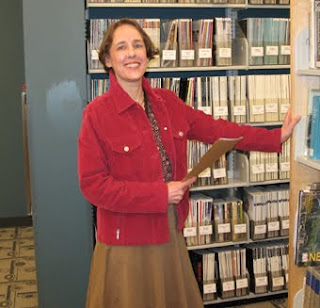Kristin Lavransdatter Readalong, Part One
"I have often prayed that you might have a yearning for the convent life," said Brother Edvin, "but not since you told me what you know. I wish that you could have come to God with your wreath, Kristin." (Kristin Lavransdatter, I: The Wreath, p. 251)
Although I wouldn't go so far as to call this medieval chick lit, the soap opera storyline at the heart of the first book in the Kristin Lavransdatter trilogy didn't really speak to me at all. In fact, I found it rather annoying at times. While I trust that the other readalong participants enjoyed The Wreath much more than I did, I should note that I did appreciate some aspects of the writing unconnected with the title character's tumultuous love affair with the bad boy Erlend Nikulaussøn and subsequent headlong descent into fallen woman status. I thought Undset was very credible from the outset, for example, at establishing the ambience for her 14th-century Norwegian setting in a land far distant from our own in time and space. Danger in one form or another is always just around the corner in the Jørundgaard community, and this sense of an everpresent menace lurking nearby provided a nice grounding for some of the more lyrical landscape descriptions and such. Despite my lack of interest in the love story, I also thought Undset was fairly convincing in terms of her characterizations. Kristin's parents Lavrans and Ragnfrid, complete opposites in terms of their outward personalities, are particularly subtly drawn in terms of their interior worlds, and there are other characters--a wayward priest here, a suspected witch there--who caught my attention when my interest in the principals was flagging. If it's always a little silly trying to come to grips with a work when you're only one-third of the way through it, the flipside of that is that I still have 800 pages left for Undset to convince me that Kristin Lavransdatter is something other than the literary equivalent of a very conventionally told costume drama. In the meantime, man, do I miss Bolaño's 2666! (http://www.penguinclassics.com/)
Nobel Laureate Sigrid Undset on a 500 Kroner Bill
Have you read The Wreath? What did you think about it? Sign up here or at my co-host Emily's blog over here if you'd like to join the readalong that's in progress (it's not too late!).
Other Kristin Lavransdatter Readalong posts on The Wreath:
Emily (Evening All Afternoon)
Claire (Kiss a Cloud)
Dawn (She Is Too Fond of Books)
E.L. Fay (This Book and I Could Be Friends)
Frances (Nonsuch Book)
Gavin (Page247)
Jason (Moored at Sea)
Jill (Rhapsody in Books)
Lena, Save Ophelia
Lu (Regular Rumination)
Sarah (what we have here is a failure to communicate)
softdrink, Fizzy Thoughts
Valerie, Life Is a Patchwork Quilt
Emily (Evening All Afternoon)
Claire (Kiss a Cloud)
Dawn (She Is Too Fond of Books)
E.L. Fay (This Book and I Could Be Friends)
Frances (Nonsuch Book)
Gavin (Page247)
Jason (Moored at Sea)
Jill (Rhapsody in Books)
Lena, Save Ophelia
Lu (Regular Rumination)
Sarah (what we have here is a failure to communicate)
softdrink, Fizzy Thoughts
Valerie, Life Is a Patchwork Quilt















